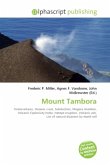Please note that the content of this book primarily consists of articles available from Wikipedia or other free sources online. Mount Lebanon, as a geographic designation, is the Lebanese mountain range, known as the Western Mountain Range of Lebanon. It extends across the whole country along about 160 km (99 mi), parallel to the Mediterranean coast with the highest peak, Qurnat as Sawda'', at 3,088 m (10,131 ft). Lebanon has historically been defined by these mountains, which provided protection for the local population. In Lebanon the changes in scenery are not connected to geographical distances, but to altitudes. The mountains were known for their oak and pine forests. Also, in the high slopes of Mount Lebanon are the last remaining groves of the famous Cedars of Lebanon (Cedrus libani). The Phoenicians used the forests from Mount Lebanon to build their ship fleet and to trade with their Levantine neighbors. However, the Phoenicians and successor rulers replanted and restocked the range so that even as late as the 16th century, its forested area was considerable.








